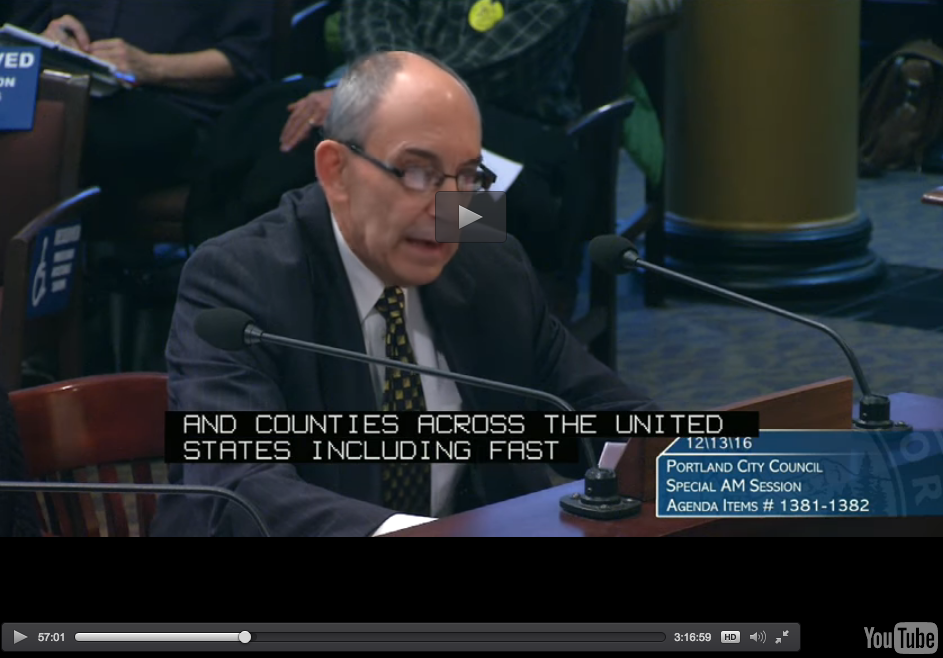At the top of most housing activist wish-lists is the idea that cities should adopt inclusionary housing requirements: when developers build new housing, they ought to be required to set-aside some portion of the units–say 10 or 20 percent–for low or moderate income families. Dozens of cities around the country have adopted some variant of the inclusionary idea.
Portland’s City Council is weighing adoption of an inclusionary housing requirement that would be among the nation’s most stringent: it would require all multi-family developments of 20 or more units to set aside 20 percent of newly constructed apartments for families earning no more than 80 percent of the region’s median household income. Unlike inclusionary zoning programs in many other cities, like New York and Chicago, which apply only when a developer is seeking an up-zoning or has some form of public subsidy, Portland’s ordinance would apply to virtually all development, including that that only seeks to build at density levels already authorized by the zoning code.
One of the principal arguments advanced by proponents of the ordinance is the policy wonk version of the “all the other kids are doing it,” refrain well known to parents everywhere. For example, in testimony to the Portland City Council on December 13, Professor George Galster assured the city council that inclusionary zoning was a well-established practice, in use widely around the country for more than forty years, concluding:
. . . they are in operation in hundreds of cities and counties across the United States, including fast-growing Portland-sized places like Denver and Minneapolis.
(Portland City Council Video, December 13, 2016 (at 56:30)
In a narrow statistical sense, that statement is mostly true: lots of places have adopted something they call “inclusionary zoning” or “inclusionary housing.” But that appellation is applied to a wide range of programs, most of them tiny or toothless. As we’ve reported at City Observatory, there’s less to most inclusionary zoning programs than meets the eye: While impressive sounding on paper (and perhaps in the press) they tend to produce very few units of new housing, typically due to the limited scope and discretionary application.
And in the case of Denver and Minneapolis, the two instances specifically cited by Dr. Galster, there’s even less that meets the eye. Minneapolis does not in fact have an inclusionary housing requirement, although it does have a voluntary density bonus for developments that include affordable housing (which no developer has apparently ever used). And, as of September, Denver has repealed its inclusionary housing requirement. Section 27-105(a) of the city’s development code had required some new developments of 20 or more units to set aside 10 percent of newly added units for households with less than 80 percent of the area’s median income. That requirement is repealed effective January 1. (For what its worth, as we reported at City Observatory earlier, the Denver program had produced a paltry 77 units since it was established in 2002). Here’s the pertinent City of Denver Ordinance:
In its place, Denver has adopted a new Permanent Housing Trust Fund, which will provide an estimated $15 million per year for the next decade to help acquire and rehabilitate low and moderate income housing. The fund will get revenue from a city-wide property tax as well as “linkage fees” on a wide variety of new development projects, including residential and commercial development. This approach was designed explicitly to spread the burden of subsidizing housing as widely as possible and avoiding creating disincentives to new residential development. And for those who think Portland is somehow lagging Denver in promoting housing affordability, Portland’s recently approved housing bond of $258 million, is actually larger than Denver’s new fund.
As a legal and policy matter, a wide variety of ordinances and programs clothe themselves in the appealing term “inclusionary housing.” But here especially, the devil is in the details. Even Mayor Bill de Blasio’s vaunted “Mandatory Inclusionary Housing” requirements apply only if developers seek up-zoning.
Here’s why this matters: Advocates are arguing that the experience of all these other places shows that inclusionary requirements have no negative effects on new privately financed housing construction. But if the programs in New York, Chicago, Denver and Minneapolis are so much smaller, are voluntary, have been repealed or simply don’t exist, then they provide no evidence that the program being proposed in Portland will not greatly reduce new housing construction–and thereby exacerbate the city’s housing shortage, and actually worsen rent inflation.
When advocates sweep these substantive policy differences under the rug, and don’t acknowledge the limited scope of real-world inclusionary programs–as well as significant back-sliding from inclusionary zoning, as in Denver, they’re mis-informing policy makers. As we pointed out earlier this month, the scope of the Portland program is much broader than virtually every other extant inclusionary zoning program and is highly likely to have a devastating effect on new housing construction. Ultimately, details matter, and sweeping claims that elide the great variation in policies that carry the appellation “inclusionary” is misleading; no better than an eight year-old claiming that “all the other kids do”–when in fact they don’t.


